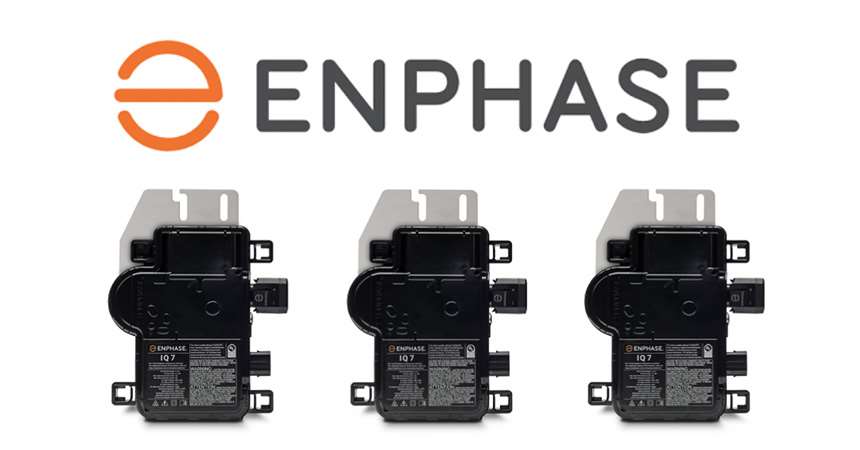Enphase Microinverter IQ8 versus IQ7: Unraveling the Differences

Enphase Microinverter IQ8 versus IQ7: Unraveling the Differences
Enphase IQ8 versus IQ7: Unraveling the Differences
Enphase's IQ8 and IQ7 microinverters are specifically crafted to transform the direct current (DC) energy produced by solar panels into alternating current (AC) usable in homes and businesses. Falling under Enphase's renowned IQ series, both these microinverters boast features such as integrated monitoring, communication functionalities, and congruence with the Ensemble energy management system. However, it's the distinctions between them that garner interest:
- The IQ8's superior maximum input voltage makes it compatible with solar panels of higher voltage, leading to enhanced efficiency and power output.
- Boasting a more substantial maximum output power, the IQ8 can cater to solar panels with higher energy production.
- In terms of warranty, the IQ8 stands out with a coverage of 25 years, while the IQ7 offers 10 years.
Simply put, the IQ8 emerges as Enphase's pinnacle of microinverter technology, with its capability to collaborate with high-voltage solar panels, superior power output, and extended warranty duration, distinguishing it from the IQ7.
A Deep Dive into Enphase Energy IQ8 and IQ7 Microinverters
Enphase Energy, a frontrunner in the microinverter market, recently unveiled the Enphase IQ8. This new entrant brings an array of advancements over the preceding Enphase IQ7. Notably, the IQ8 showcases an elevated maximum current output and the unique capability to deliver off-grid power without the necessity of a backup battery system. While typical solar systems go offline during blackouts for safety reasons, the Enphase IQ8, when paired with an Enphase Smart Switch, seamlessly isolates itself from the grid, ensuring uninterrupted energy supply during daylight hours.
Comparing the IQ8 and IQ7: Should You Make the Shift?
The IQ8 series introduces six variants designed to cater to an array of solar panels suitable for both residential and commercial needs:
Product MaxInput Max Output
IQ8 235 W - 350 W 245 VA
IQ8+ 235 W – 440 W 300 VA
IQ8M 235 W - 460 W 330 VA
IQ8A 295 W - 500 W 366 VA
IQ8H 320 W - 540+ W 384 VA
IQ8H 208v 295 W - 500+ W 366 VAWhile each member of the IQ8 family shares fundamental functions, their distinguishing factor is the power capacity. As per Enphase's information, the core features consistent across all IQ8 microinverters are:
- Compliance with PV Rapid Shut Down
- User-friendly due to their lightweight, compact nature, and intuitive plug-n-play connectors
- Efficient Power Line Communication (PLC) amidst components
- Streamlined installation courtesy of a simple two-wire system
- Capability to generate energy even during grid failures
- Subjected to over a million cumulative testing hours
- Equipped with a Class II double-insulated enclosure
Choosing the Ideal IQ8 Microinverter for Your Needs
Given the six IQ8 models, each tailored for varying power requirements, it's crucial to align your choice with the specific output of the solar panels. Residential solar setups typically feature panels measuring roughly 65x40 inches, whereas commercial endeavors opt for larger panels approximately 78x40 inches in size.
For projects utilizing larger panels with greater electricity generation, it's apt to choose higher-capacity models like the IQ8M, IQ8A, and IQ8H. Conversely, residential panels, peaking around 400 watts, are best suited for the IQ8 and IQ8+.
It's worth noting that it's often strategic to opt for an inverter with a marginally lower power capacity than the solar panel's peak output. For instance, with a 375-watt solar panel, you might presume the need for an IQ8+. However, these peak outputs are generally realized under optimal conditions, which might occur infrequently. As such, a more cost-effective strategy might involve settling for a slightly less powerful inverter and accepting minimal "losses" during those rare high-performance days.
This phenomenon, known as inverter clipping, is a conscious choice in numerous solar systems' design. Should your solar specialist suggest an inverter that seemingly undervalues your system, initiate a conversation about inverter clipping. For a comprehensive understanding, delve into our detailed piece on the subject.
SEE HOW MUCH YOU CAN SAVE BY GOING SOLAR
CALCULATE YOUR SAVINGS
